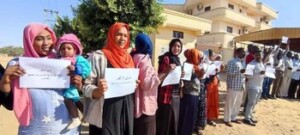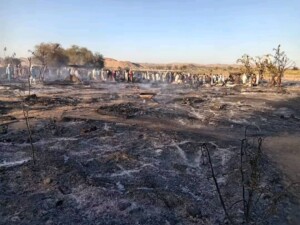Youth Employment report: Only 12% of Sudanese in ‘decent work’
According to a Challenge Fund for Youth Employment (CFYE) report, published in February 2021, Sudanese people face many hurdles in finding decent work including poor wages, informal employment, legal obstacles, and underemployment.
 Protesting Khartoum University graduates hold banners which say 'I'm unemployed' during a protest in 2019 (Social media)
Protesting Khartoum University graduates hold banners which say 'I'm unemployed' during a protest in 2019 (Social media)
According to a Challenge Fund for Youth Employment (CFYE) report, published in February 2021, Sudanese people face many hurdles in finding decent work including poor wages, informal employment, legal obstacles, and underemployment.
The report aims to identify key opportunities for impact on youth employment in Sudan in the short to medium term.
The CFYE was launched in 2019 by the Dutch Ministry of Foreign Affairs to create more, better, and more inclusive jobs for 200,000 young people in the Sahel, the Horn of Africa, the Middle East, and North Africa. The fund will support projects which offer solutions to create and improve jobs and better placement opportunities for young women and men.
Sudan is a low-income country that is in the midst of an economic and political transition. In February, the Khartoum government effectively floated the Pound and unified the official and parallel exchange rates in an attempt to control the rising inflation and attract foreign investors. When Prime Minister Abdallah Hamdok was sworn into office on August 21, 2019, the veteran economic expert said his programme would be based on the slogan of the December Revolution: “Freedom, Peace, and Justice”.
Sudan has high rates of poverty. 13.5 per cent of people lived in extreme poverty (less than USD 1.90 per day) and 46 per cent in moderate poverty (less than USD 3.20 per day) in 2014. Poverty is still significantly higher in rural areas but has risen sharply in urban areas in recent years, according to the report. For instance, in Khartoum state, extreme poverty climbed from 3.3 per cent in 2009 to 9.4 per cent in 2014.
The report concluded that only 12 per cent of all the jobs meet all International Labour Organisation (ILO) criteria for decent work, based on data gathered from the Sudan Labour Force Survey (SLFS) in December 2011.

The SLFS survey recorded that 29.5 per cent of all employees received wages below the poverty line, and recorded a 47 per cent gender pay gap.
The “huge” gender income difference was more or less constant across urban and rural areas, even though the average monthly wage of women in rural areas was slightly below the monthly minimum wage. Only one in every three working-age women are either employed or actively seeking employment, compared to three in four men.
Although women are less likely to participate in the labour force, those who do are considerably more likely to be unemployed and those who work earn lower wages than men. Gender gaps in the labour market remain prevalent due to legal obstacles to women’s economic activities in Sudan, according to the report. “Women cannot, in the same way as men, work the same night hours, perform jobs deemed hazardous, arduous, or morally inappropriate, or perform the same tasks or work in the same industries.”
According to the CFYE, youth unemployment in urban areas also increased sharply between 2009 and 2014, from less than 20 per cent to almost 40 per cent. Unemployment is especially high among university (or higher qualified) graduates in Sudan.
Other work
A significant portion of the Sudanese workers is engaged in the informal sector, with 85% of workers engaged in vulnerable employment and 60 per cent of the labour force engaged in subsistence agriculture. Informality is particularly prevalent in the agricultural, transportation, construction, trade, and repair services sectors.
Besides high levels of informal work and unemployment, the labour force also has a high level of underemployment. According to the SLFS, 31 per cent of all employed individuals were classified as part-time employed, 34 per cent of all rural and 26 per cent of all urban workers. Underemployment is likely to be higher in the informal sector, as the employee is not protected by any kind of labour legislation.

The report recommends creating jobs in “fast-growing industrial sectors such as manufacturing and agribusiness” and “increasing productivity by introducing tech-based solutions”. In addition, matchmaking platforms connecting youth to jobs and increasing awareness of job opportunities, “youth upskilling” and “vocational training” (particularly for women), and improving public transport could aid employers in finding suitable candidates for entry level positions.
Improving the decency or quality of jobs that youth are currently employed in is also focused on in the report, especially among blue-collar jobs in the industrial or agricultural sector. The report recommends focus on the creation of a living income wage, security in the workplace, social protection, prospects for personal development, and equality of opportunity and treatment.
Sudan economy
Sudan's economy continues to suffer as inflation rises and commodity prices sore. OCHA, the UN Office for the Coordination of Humanitarian Affairs, reported that the inflation rate of the Sudanese Pound (SDG) was at 342 per cent in March, an increase of 11 points from 331 per cent in February. According to OCHA, this price increase is mainly due to the depreciation of the local currency.
Earlier this year, protests spread throughout Khartoum and a number of other cities and towns in response to price increases and the general lack of bread, fuel, and water.











 and then
and then